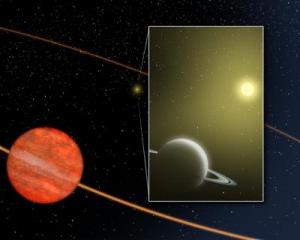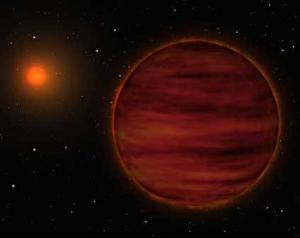Brown Dwarf Stars

_______________________________________________________
This is an artist's concept of the star HD 3651 as it is orbited by a close-in Saturn-mass planetary companion and the distant brown dwarf companion discovered by Spitzer infrared photographs. The Saturn-mass planet was discovered through Doppler observations in 2003. Its orbit is very small, the size of Mercury's, and is highly elliptical. The gravity of the distant brown dwarf companion may be reponsible for the distorted shape of the inner planet's orbit.
(Credit: NASA / JPL-Caltech / T. Pyle (SSC))
First Images Of Brown Dwarf In Planetary System
Scientists using NASA's Spitzer Space Telescope have discovered and directly imaged a small brown dwarf star, 50 times the mass of Jupiter, orbiting with a planet around a Sun-like star. Such an arrangement has never before been seen but might be common, the scientists say, leading to solar systems with distorted planetary orbits.
The discovery concerns a class of the coldest brown dwarfs, called T dwarfs.
Over the last ten years, astronomers have been extremely successful in finding planets close to their host stars using indirect detection methods," said Luhman, an assistant professor in the Penn State Department of Astronomy and Astrophysics. "Because of its infrared capabilities, Spitzer is well suited for directly detecting cool T dwarfs, and perhaps even large planets, in the outer parts of planetary systems."
Luhman's team also discovered a second brown dwarf that is smaller yet, about 20 times the mass of Jupiter, orbiting another star. This smaller object could be the youngest T dwarf known, offering scientists a snapshot of early brown-dwarf development. The two T dwarfs are the first to be imaged by Spitzer. Shortly after these companions were found, Spitzer also discovered a T dwarf that is floating through space by itelf rather than orbiting a star. The team that discovered that T dwarf is led by Daniel Stern at NASA's Jet Propulsion Laboratory.
Brown dwarfs are small stars that are not massive enough to burn hydrogen, like our Sun does. Their cores are not hot enough to trigger such nuclear fusion. As a result, their surface temperature is only a few thousands of degrees when young, cooling considerably to about the temperature of a planet as they age. Consequently, they are dim and hard to identify and, as a result, the first unambiguous identification came only about ten years ago.
The more massive of the two newly discovered T dwarfs is called HD 3651 B, located in the constellation Pisces. This object is in a solar system containing a star slightly less massive than our Sun that is orbited by a planet slightly smaller than Saturn.
The planet's orbit around the Sun-like star is highly elliptical, which had suggested that the gravity of some unseen object farther away from the star was pulling the planet outward. Sure enough, it was a T dwarf. Many extrasolar planets have been discovered with highly elliptical orbits. The Spitzer discovery is the first evidence to support the theory that small companions such as T dwarfs can hide in such solar systems and can cause the orbits of planets to be extreme.
"The orbit of the planet in this system is similar to Mercury's, but the T dwarf has an orbit over ten times larger than Pluto's," said Brian Patten of the Harvard-Smithsonian Center for Astrophysics (CfA), a co-author. "Although HD 3651 B would be just beyond naked-eye visibility to an intrepid astronomer living on this system's planet, the T dwarf makes its presence known through gravity."
The other T dwarf is called HN Peg B in the constellation Pegasus. Whereas most brown dwarfs are billions of years old, HN Peg B is relatively young, only about 300 million years old. The scientists determined its age by carefully studying the companion star, which was formed at the same time from the same gas cloud. The system also contains a previously discovered disk of dust and rocks.
"Detectable debris disks and T dwarf companions are fairly rare, so the presence of both around the same star makes this a particularly exciting star system," said Giovanni Fazio of CfA, a co-author.
The discoveries were made with Spitzer's infrared camera, built primarily at NASA Goddard Space Flight Center in Greenbelt, Maryland. The instrument's principal investigator is Giovanni Fazio. Other team members include Massimo Marengo, Joseph Hora, Richard Ellis, Michael Schuster, Sarah Sonnett, Elaine Winston, and Robert Gutermuth of the CfA; John Stauffer of Caltech; Tom Megeath of the University of Toledo; Dana Backman of the SOFIA/SETI Institute; Tod Henry of Georgia State University; and Michael Werner of NASA Jet Propulsion Laboratory.
The Jet Propulsion Laboratory, in Pasadena, California, manages the Spitzer Space Telescope mission for NASA's Science Mission Directorate, Washington. Science operations are conducted at the Spitzer Science Center at the California Institute of Technology in Pasadena.
Source: Kevin Luhman, Penn State Astro
Science Daily press releases 19th Sept 2006
_______________________________________________________

__________________________________________
Artist's impression of the SCR 1845-6357 stellar system. The small red star is shown in the background while the newly discovered brown dwarf is at front. (Image courtesy of European Southern Observatory)
The Sun's New Exotic Neighbor: A Very Cool Brown Dwarf
Using the European Southern Observatory's Very Large Telescope in Chile, an international team of researchers discovered a brown dwarf belonging to the 24th closest stellar system to the Sun. Brown dwarfs are intermediate objects that are neither stars nor planets. This object is the third closest brown dwarf to the Earth yet discovered, and one of the coolest, having a temperature of about 750 degrees Centigrade. It orbits a very small star at about 4.5 times the mean distance between the Earth and the Sun. Its mass is estimated to be somewhere between 9 and 65 times the mass of Jupiter.
At a time when astronomers are peering into the most distant Universe, looking at objects as far as 13 billion light-years away, one may think that our close neighbourhood would be very well known. Not so. Astronomers still find new star-like objects in our immediate vicinity. Using ESO's VLT, they just discovered a brown dwarf companion to the red star SCR 1845-6357, the 36th closest star to the Sun.
"This newly found brown dwarf is a valuable object because its distance is well known, allowing us to determine with precision its intrinsic brightness", said team member Markus Kasper (ESO). "Moreover, from its orbital motion, we should be able in a few years to estimate its mass. These properties are vital for understanding the nature of brown dwarfs."
To discover this brown dwarf, the team used the high-contrast adaptive optics NACO
Simultaneous Differential Imager (SDI) on ESO's Very Large Telescope, an instrument specifically developed to search for extrasolar planets. The SDI camera enhances the ability of the VLT and its adaptive optics system to detect faint companions that would normally be lost in the glare of the primary star. In particular, the SDI camera provides additional, often very useful spectral information which can be used to determine a rough temperature for the object without follow-up observations.
Located 12.7 light-years away from us, the newly found object is nevertheless not the closest brown dwarf. This honour goes indeed to the two brown dwarfs surrounding the star Epsilon Indi, located 11.8 light years away.
However, this newly discovered brown dwarf is unique in many aspects. "Besides being extremely close to Earth, this object is a T dwarf - a very cool brown dwarf - and the only such object found as a companion to a low-mass star," said Beth Biller, a graduate student at the University of Arizona and lead author of the paper reporting the discovery. "It is also likely the brightest known object of its temperature because it is so close."
The discovery of this brown dwarf hints that, at least close to the Sun, cool brown dwarfs prefer to be part of a couple with a star or another brown dwarf, rather than wandering alone in the cosmic emptiness. Indeed, of the seven cool brown dwarfs that reside within 20 light years of the Sun, five have a companion.
The work presented is a Letter to the Editor in the Astrophysical Journal:
"Very Nearby to the Sun: A Methane Rich Brown Dwarf"
Source: European Southern Observatory
Science Daily press releases 22nd March 2006
_______________________________________________________
_______________________________________________________
Labels: Brown Dwarfs, ESO, JPL, Stars


<< Home